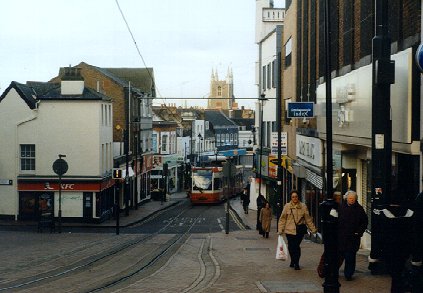The difference between trams and light rail are subtle, but real. Its all about capacity, trams don't have the modular design where you can join 4 train cars together and aren't usually platform based.
BTW CDL, all your photos are a tram because it doesn't have the connector to conjoin other train cars. Looking at this high-res image you can clearly see the piece that joins other train cars for doubling, tripling, or quadripling capacity:
http://bombardier.com/files/en/supporting_docs/image_and_media/products/BT-2442-CologneHR.jpg
No such feature exists on the smaller trams, which aren't as long per car.
http://bombardier.com/files/en/supporting_docs/image_and_media/products/BT-3488-Valencia-HR.jpg
As W.S. hinted at, its not just the conjoining feature, trams are literally smaller per vehicle usually speaking. I know in Portland the MAX Light Rail cars are noticably larger than the Portland Streetcar, as I used the system quite frequently.
Trams are different from Light Rail, even thought the differences can be subtle. If a tram could conjoin with many cars, it would be almost identical.
I'm sure there is a light rail vendor somewhere in the world that offers a smaller tram-style car that can conjoin to further blur the definition and differences, but we're talking about Bombardier now that we know its the vendor of choice for the TTC and Transit City.
The Bombardier Flexity Tram is both a smaller individual car and cannot conjoin in a modular design like Bombardier Flexity Light Rail vehicles.
And CDL, just so you know my personal preference was to have a TTC subway extension of Sheppard to Scarborough Centre and Pearson, an Eglinton TTC subway from Pearson to Kennedy, and a DRL subway built in full over Transit City.
But now that TC is a go, you have to find the silver lining in the fact that Light Rail isn't as bad as a streetcar, and it can do the job. I've accepted the fact its being built, and having the experience of living in Portland for a year I got familiar with the difference of light rail and trams quite well.
What is most frustrating is we don't have all the information. It appears they are building parts of Transit City, like St Clair, with a Tram model and they are building other parts, like Eglinton LRT, with full blown Light Rail.
The schematics I've seen for St Clair have one tram car like your photos represent, in a Euro-style street platform.
The information I'm getting for Eglinton LRT is that its using a higher grade platform system with modular, larger Light Rail vehicles. And I'm hearing from certain sources that Eglinton LRT will be able to handle 3 light rail vehicles per platform on all stations, which is
not a small capacity system. That is heavier than the Docklands Light Rail system in London, only Eglinton will have the problem of crossing street intersections outside the tunnel.
But right now the TC designers haven't confirmed enough for us to get the final word, which is arguably the most frustrating part of TC. They aren't spitting out enough specs on the system as of yet.



























